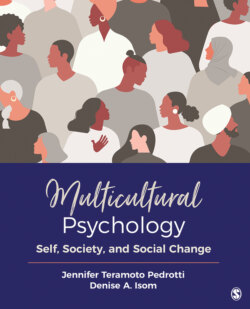Читать книгу Multicultural Psychology - Jennifer T. Pedrotti - Страница 39
На сайте Литреса книга снята с продажи.
Conclusion
ОглавлениеToday’s racial climate, our interactions within and between racial groups, and our racialized identities all emerge from our history. More than a set of attitudes and behaviors, race is embedded and operationalized in our institutions, systems, structures, and social practices. The psychologist Beverly Tatum describes race as an unavoidable smog: “Sometimes it is so thick it is visible, other times it is less apparent, but always, day in and day out, we are [all] breathing it in” (2017, p. 6). For some of us that “smog” reflects an oppressive system we must learn to navigate. For others, the smog is nearly invisible or unknown, whether from ignorance or “ignore(ance)” (not wanting to know or intentionally ignoring). Still others are finding themselves and clarity as they work through the dissonance created when reality/history reveal our internalized false social narratives.
Back to the police shootings from earlier in the chapter. To see them as a new phenomenon is to miss the long history of racial violence, from Indian wars to slave patrols to lynchings to today’s racial climate. To see immigration as only a current political hot button is to miss the foundational role of economic policies and social ideologies of the past (and today), on which the current political moment is based. To see racial segregation as an issue of preference or a product of individual success is to miss the intentional policies designed to create and sustain the inequalities that are its foundation.
A few years ago, one of us (DI) team-taught a course called Global Origins of US Cultures with a colleague in the ethnic studies department who regularly utilizes community-based research as a pedagogical tool. She devised a final project for our classes that centered on that approach. From her own research, she knew that our largely White, affluent college town had a long, rich, and varied ethnic history. What we then required of students was to form groups and explore an ethnic population that used to live in the city of San Luis Obispo. They were tasked with finding out where and how the population lived, and most important, why they were no longer there.
At the end of the quarter, we put on a bike tour of San Luis Obispo’s ethnic history. Campus and community members could follow our designated route through those historical neighborhoods and hear student presentations of their findings at each stop. The research alone had value, but the biggest lesson for our students, and the tour participants, was how much we could not trust our own stories, what we thought we knew, what we saw as the reality of our social world. Students, and many residents, thought of San Luis Obispo as happenstantially White and affluent. Most thought that the proximity to the ocean and the nature of the small, rural, college town simply drew a wealthier and Whiter population.
What they found among the histories was that there had been a large and vibrant Chinese community, one that was instrumental in building the roads in the area, but that was eventually seen as a threat to White labor and forced out of jobs and out of town. There was also a strong Japanese community, one of California’s Japanese farming communities that were responsible for nearly 40% of the state’s vegetable production before World War II. The members of this community lost their homes and farms when they were interned during the war. And the stories went on. The students found that the Whiteness they currently experience in San Luis Obispo is not “natural” and was not inevitable; it has its roots in the racialized economic, political, and social policies of the past.
Multicultural psychology draws attention to the need to understand the social context of an individual as central to understanding the individual. Insight into one’s psyche does not begin and end with that person. We all come to self in a social network and milieu, and that environment is embedded within and emergent from a sociohistorical foundation. Constructions of race and gender were not simply ideas. Those concepts became shared narratives, they informed policy, institutions, and social practice. We internalized them. These constructions informed our sense of ourselves and others. It is clear, in order to effectively build relationship, counsel, assess, advise, or analyze, we must start with an understanding of the workings and operational nature of race. That understanding is the foundation for effective use of culturally responsive counseling.
